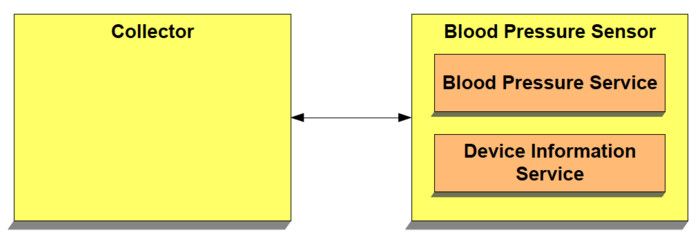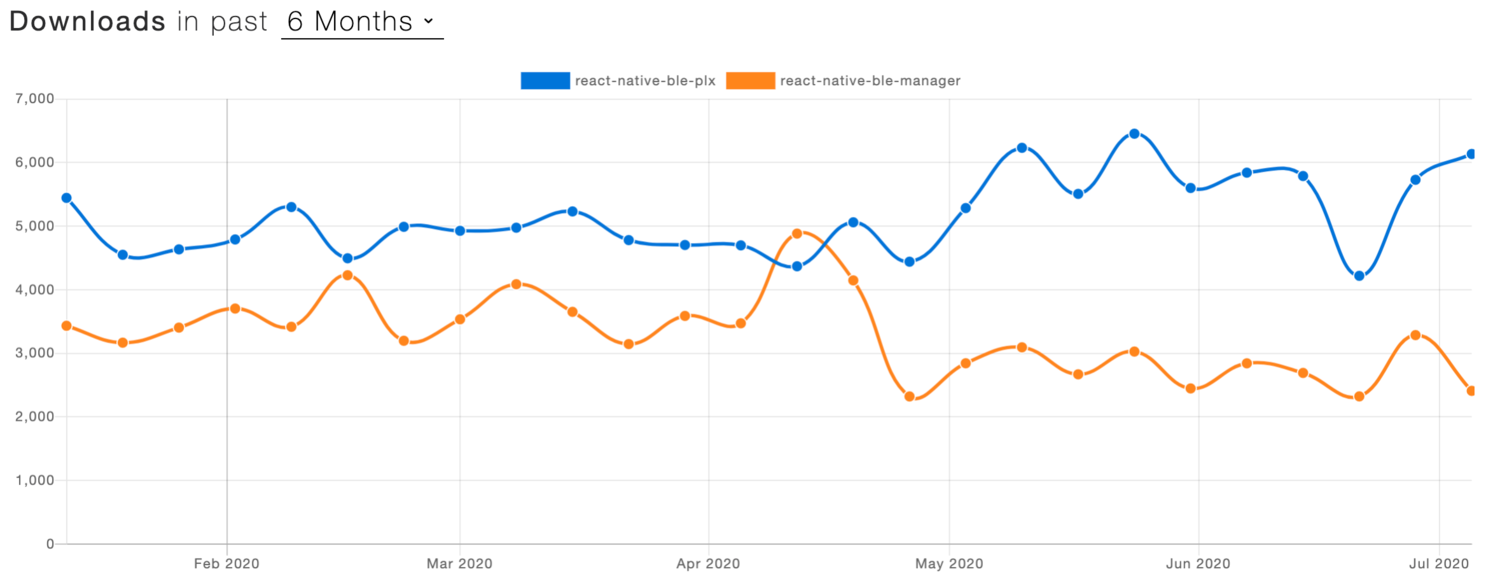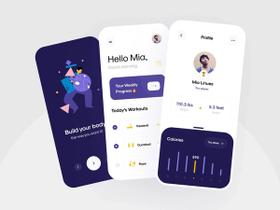BLE in React Native App: How-to-Integrate Guide
Published: May 19, 2024
13 min read
In this article, you'll learn:
1
📳 Bluetooth Low Energy: The Main Concepts and Difference from Classic Bluetooth
2
⚙️ 2 Main Libraries for BLE Integration in React Native
3
⚖ react-native-ble-plx vs react-native-ble-manager Comparison
4
✅ Apps to Test BLE Devices
5
⚠️ Possible Pitfalls when Integrating BLE Devices
6
💡 Takeaways: So, Which One to Choose?
Bluetooth Low Energy (or simply BLE) devices are extremely popular these days. We, as a BLE app development company, have already worked on a few projects involving BLE devices, such as one regarding vaping and another focused on fitness tracking devices.
In this article, we will specifically focus on the React Native BLE integration. However, how is this technology different from classic Bluetooth? And what are its key concepts? A brief explanation is below!
📳 Bluetooth Low Energy: The Main Concepts and Difference from Classic Bluetooth
We all know what Bluetooth is — a short-range wireless networking protocol that quickly connects devices. Currently, it has 2 versions: Bluetooth Classic and Bluetooth Low Energy.
- Bluetooth Classic is often referred to as just Bluetooth. This technology can support continuous connections and transfer big amounts of data. This might include phone calls, audio streaming, and data.
- Bluetooth Low Energy , also known as BLE, incorporates a BLE stack optimized for low power sensors and accessories. This is a version of Bluetooth that is adapted to low power sensors and accessories. Such devices, often used in IoT prototypes due to their long battery life capabilities, don’t require continuous connection. They are especially popular in the fitness, healthcare, security, home entertainment industries, and beacons.
Read also our guide on how to integrate BLE-Based Fitness Devices into your App.
What are the main terms you need to know when working with this technology? Check below!
Key concepts for BLE 📖
Before diving into BLE React Native integration for companion mobile app development, it’s important to know how this technology works. We won’t focus on that too much but will still review some key concepts.
GATT stands for Generic Attribute Profile that defines how BLE devices transfer data. To make data transfer possible, devices should have a dedicated connection.
BLE devices are often referred to as peripheral devices, while smartphones, tablets, and other similar gadgets — as central devices. Every specific BLE device, referred to as a peripheral device, can have an exclusive connection with one central device at a time, while the central device can be simultaneously connected to multiple other peripherals:

Connection between a central and peripheral devices (image by Kevin Townsend)
Since we’re talking about GATT, let’s take a closer look at the server/client relationship:
- From that perspective, the peripheral device is known as the GATT Server that contains data.
- The central device, designed to automatically connect to peripherals, acts as the GATT Client that sends requests to the server.
The Client initiates all the transactions by asking the Server, which could also be a remote device, for data. There are 2 ways to transfer data from the Server to the Client: Notifications and Indications.
- Notification is a one-way message. It's faster since it doesn’t ask the Client whether they've received the message.
- Indication describes the system of two-way communication. The Server sends a message, and in response, ➡️ the Client receives the message and sends a confirmation message back to the Server ➡️ thus, the Server knows that the initial message has reached the Client.
Data transfer itself is based on a few high-level objects: Profiles, Services, and Characteristics.

The hierarchy of Profiles, Services and Characteristics (image by Kevin Townsend)
- Profile is a predefined set of Services.
- Services break up data into logic blocks that consist of Characteristics.
- Characteristic is a single data point, including an array of related data like X/Y/Z values from a 3-axis accelerometer.
Here's an example of how it may look for a fitness tracking device:

Example of Profile structure (image by Mohammad Afaneh)
If we break down the example above into smaller pieces:
Profile | Blood Pressure | |
Services | Blood Pressure Service | Device Information Service |
Characteristics | Intermediate Cuff Pressure | Manufacturer Name String |
You can read a bit more on GATT, Profiles, Services and Characteristics here, and on Notifications & Indications — here.
Nevertheless, let’s get back to today's main topic!
⚙️ 2 Main Libraries for BLE Integration in React Native
As of July 2020, there are 2 libraries that can be used for Bluetooth Low Energy React Native integration:
- react-native-ble-plx
- react-native-ble-manager
❗️ Important note: this article is based on v.7.3.0 of react-native-ble-manager and v.2.0 of react-native-ble-plx
Let’s take a closer look!
🛠 react-native-ble-plx
GitHub | Documentation | Wiki
React Native BLE PLX is one of the 2 libraries you can use to work with this technology. It supports all the key features:
- observing the adapter state of the device’s Bluetooth, which is crucial for enabling functionalities like a scan button;
- connecting to discovered peripherals;
- scanning for nearby BLE devices;
- discovering services;
- discovering, reading and writing characteristics;
- observing indications & notifications;
- negotiating MTU;
- reading RSSI;
- working in background mode on iOS;
- turning on the Bluetooth adapter of the device.
Yet, the library doesn’t support the following features:
- peripheral support that enables the communication between phones through BLE;
- creating bonds with peripheral devices;
- working with Bluetooth Classic devices.
The new (2.x) version of the library supports all the latest RN versions starting from 0.60. However, you can still use the old version of the library even up to 0.60.5 RN version, but with additional changes.
As for OS versions, the library works on iOS 9+ and Android API 19+.
⚒ react-native-ble-manager
This library offers an alternative for BLE mobile app development and integrating BLE in React Native applications.
Despite the absence of an explicit features list, we have identified the key BLE functionality based on method names. It includes all the features react-native-ble-plx has and a few additional ones such as:
- bonding peripherals;
- requesting connection priority;
- getting connected & bonding peripherals.
For a practical BLE use case in urban transportation, explore how to build an e-scooter app.
The latest version of the BLE manager React Native library supports RN 0.60 and newer. However, the older version of the library can be used with older RN versions:
- React Native 0.40-0.59 is supported until 6.7.X
- React Native 0.30-0.39 is supported until 2.4.3
As for OS versions, this library covers iOS 8+ and Android API 18+.
⚖ react-native-ble-plx vs react-native-ble-manager Comparison
We’ve also made a few comparison tables to cover the main differences between the two libraries:
✅ Compatibility | ||
|---|---|---|
react-native-ble-plx | react-native-ble-manager | |
🚀 RN version | 0.60+ | 0.60+ |
🍎 iOS version | 9+ | 8+ |
🤖 Android version | 19+ | 18+ |
A closer examination of features reveals that, by importing ble-manager, developers gain access to additional possibilities:
⚙️ Features | ||
|---|---|---|
Feature | react-native-ble-plx | react-native-ble-manager |
observing device's Bluetooth adapter state | ✅ | ✅ |
scanning BLE devices | ✅ | ✅ |
making connections to peripherals | ✅ | ✅ |
discovering services/characteristics | ✅ | ✅ |
reading/writing characteristics | ✅ | ✅ |
observing characteristic notifications/indications | ✅ | ✅ |
reading RSSI | ✅ | ✅ |
negotiating MTU | ✅ | ✅ |
background mode on iOS | ✅ | ✅ |
turning the device's Bluetooth adapter on | ✅ | ✅ |
communicating between phones using BLE (Peripheral support) | ❌ | ❌ |
bonding peripherals | ❌ | ✅ (Android only) |
checking if specific peripheral is connected | ✅ | ✅ |
getting bonded peripherals | ❌ | ✅ (Android only) |
getting connected peripherals | ❌ | ✅ |
refreshing cache | ✅ (Android only) | ✅ (Android only) |
requesting connection priority | ❌ | ✅ (Android API 21+ only) |
Written in TypeScript | ✅ | ✅ |
Finally, we can also compare some GitHub stats:
📊 GitHub Stats (on 12.06.20 | ||
|---|---|---|
Stats | react-native-ble-plx | react-native-ble-manager |
⭐️ Stars | 1.8k | 1.1k |
⚠️ Issues | 19 | 51 |
🍴 Forks | 281 | 443 |
👨💻 Contributors | 34 | 79 |
👩💻 Used by | 662 | 505 |
💻 Commits | 672 | 583 |
In general, react-native-ble-plx is more popular among developers:

You can find even more smaller details on react-native-ble-plx here, and on react-native-ble-manager here.
✅ Apps to Test BLE Devices
When developing a mobile appication for BLE integration, such as in fitness tracker app development, it’s crucial to test how it will function with compatible devices. Our team used the following apps:
These tools are quite similar and provide many options to test different features of Bluetooth Low Energy devices.
For developers working across multiple protocols, understanding BLE vs ANT+ can guide effective testing strategies for diverse device ecosystems.
🤓 BLE and React Native Integration Guide
This guide is designed to walk you through the seamless integration of BLE into your React Native mobile applications using the react-native-ble-manager library. It is based on the 11.3.1 version of react-native-ble-manager (which is the most popular in February 2024).
Whether you aim to develop a fitness app that monitors health devices or controls smart home gadgets, or needs to communicate with other BLE-equipped devices, this guide will provide you with a solid foundation. We'll start by guiding you through the installation process of the react-native-ble-manager for both Android and iOS platforms, ensuring you have a smooth setup experience. Given the intricacies of BLE technology and the diverse ecosystem of devices, a thorough understanding of the installation process is crucial for avoiding common pitfalls.
Following the setup, we delve into practical examples and detailed explanations of the library's main methods—such as initializing the manager, scanning for peripherals, discovering services, connecting to devices, and retrieving services.
Install
The library support the react native autolink feature.
npm:
Yarn:
To use BLE in your app, you need to set specific permissions.
Android
Update your manifest file.
If you need communication while the app is not in the foreground you need the ACCESS_BACKGROUND_LOCATION permission.
For more information, refer to the official documentation.
Runtime permissions must also be requested from users using PermissionsAndroid, check the example.
iOS
Update the Info.plist file.
In iOS >= 13 you need to add the NSBluetoothAlwaysUsageDescription string key.
If the deployment target is earlier than iOS 13, you also need to add the NSBluetoothPeripheralUsageDescription string key.
For background use you need to add central-peripheral in UIBackgroundModes key. Refer to the documentation.
Usage (main methods)
Start(options)
The library must be initialized before use through the start method. This can be done at the launch of the application or just before the actual use of BLE.
scan(serviceUUIDs, seconds, allowDuplicates, scanningOptions)
Scan for available peripherals.
Discover peripheral (event)
The scanning find a new peripheral.
connect(peripheralId, options)
Attempts to connect to a peripheral. In many case if you can’t connect you have to scan for the peripheral before.
retrieveServices(peripheralI, serviceUUIDs])
Retrieve the peripheral’s services and characteristics.
We described install instructions and main methods of react-native-ble-manager which are needed for most use cases.
To view the parameters of each listed method or other methods (like start notifications, read and write) and events (like receive notifications), consult this documentation.
⚠️ Possible Pitfalls when Integrating BLE Devices
During BLE integration, our developers identified several pitfalls, including IoT security issues and solutions, and the underutilization of event listeners, which can streamline the handling of BLE events and make the development process smoother and potentially increase the IoT software development cost. Here are our recommendations on how you can make the development go smoother.
# 1: Turn on geolocation 🌍
If you’re developing an Android application, this one will be important. As written in this documentation: “Starting from Android API 23+, to access the hardware identifiers of nearby external devices via Bluetooth and Wi-Fi scans, your app must now have the geolocation enabled”.
To check whether the geolocation is enabled and turn it on in case it isn't, which is crucial for accessing the hardware identifiers (such as the device identifier) of nearby external devices via Bluetooth, we recommend using the react-native-android-location-enabler library.
# 2: Turn on Bluetooth 📳
Obviously, you need to turn on Bluetooth on the mobile device before scanning. For this purpose you may use the methods of the mentioned libraries:
Another common challenge with Android BLE connection is managing background connectivity, as Android devices impose restrictions on scanning and maintaining persistent BLE connections.
# 3: Change device name 📱
When using react-native-ble-plx, you may stumble upon a bug which will prevent you from being able to change the device name. That can happen in case the name is cached. This issue is tracked here.
# 4: Keep code quality high 🏆
Finally, here are a few general tips to improve the code quality:
- Keep all of the characteristics, UUID services, and relevant modules in one centralized location for better management.
- Avoid magic numbers in characteristics. Instead, use constants.
- Organize the logic structure into 2 separate container files:
- one file to keep the logic that contains code that isn't related to communication with a specific device (e.g. scanning process, connection, disconnection);
- another file for the code that contains communication with a specific device — discovering services/characteristics, observing notifications/indications, reading/writing characteristics, etc.
When integrating BLE into a React Native app, reviewing our Web Bluetooth demo can provide valuable insights.
💡 Takeaways: So, Which One to Choose?
Simple but true: the best choice, as illustrated in our react native BLE examples, is always the one that matches your needs better than all the other options. Thus, we'd recommend you to consider things like:
- the required features;
- the RN version used in the project;
- the OS versions you’d like to cover.
Got questions about integrating React Native BLE? We'll help clarify everything for you! Send us a message and we'll solve your problem.
Our clients say
![Stormotion client Pietro Saccomani, Founder from [object Object]](/static/40e913b6c17071a400d1a1c693a17319/b0e74/pietro.png)
They make the whole business work for us, and their improvements are fundamental to our operations. They’re reliable, honest, and willing to try new things that will help us. We appreciate how flexible and easygoing they are.
Pietro Saccomani, Founder
MobiLoud
Was it helpful?
Questions you may have
Take a look at how we solve challenges to meet project requirements
What are the prerequisites for BLE integration in a React Native app?
Before integrating BLE in a React Native app, it's crucial to understand how BLE technology works, including its key concepts like GATT (Generic Attribute Profile), peripheral and central devices, and the data transfer mechanisms (Notifications and Indications). Understanding these concepts is essential for effective BLE integration.
What are the available libraries and plugins for BLE integration in React Native?
As of July 2020, there are two main libraries for BLE integration in React Native:
- react-native-ble-plx: Supports observing the adapter state, connecting to peripherals, scanning BLE devices, discovering services and characteristics, observing indications & notifications, negotiating MTU, reading RSSI, and working in background mode on iOS. It does not support peripheral support, creating bonds with peripheral devices, or working with Bluetooth Classic devices.
- react-native-ble-manager: Offers similar functionalities to react-native-ble-plx and includes additional features such as bonding peripherals, requesting connection priority, and getting connected & bonding peripherals.
How to set up BLE permissions and configurations in React Native?
For Android mobile applications, starting from Android API 23+, accessing hardware identifiers of nearby external devices via Bluetooth and Wi-Fi scans requires geolocation to be enabled. To check and enable geolocation, the react-native-android-location-enabler library is recommended.
What are the best practices for BLE device discovery and connection?
- Ensure Bluetooth is turned on the device before scanning.
- Keep all characteristics and UUID services in one place to avoid confusion.
- Use constants instead of magic numbers in characteristics.
- Organize logic structure into separate files for better code management and clarity.
What considerations should be made for handling Bluetooth device pairing and security?
While the blog post does not specifically address pairing and security, general best practices include ensuring secure connections, implementing authentication and encryption where necessary, and managing device bonding properly to prevent unauthorized access.
What resources and documentation are available for further learning and troubleshooting?
For further learning and troubleshooting, the documentation and GitHub repositories of the libraries react-native-ble-plx and react-native-ble-manager are valuable resources. Additionally, the Adafruit Learning System and NXP community provide extensive information on BLE technology, including GATT, Profiles, Services, and Characteristics.
Read also




